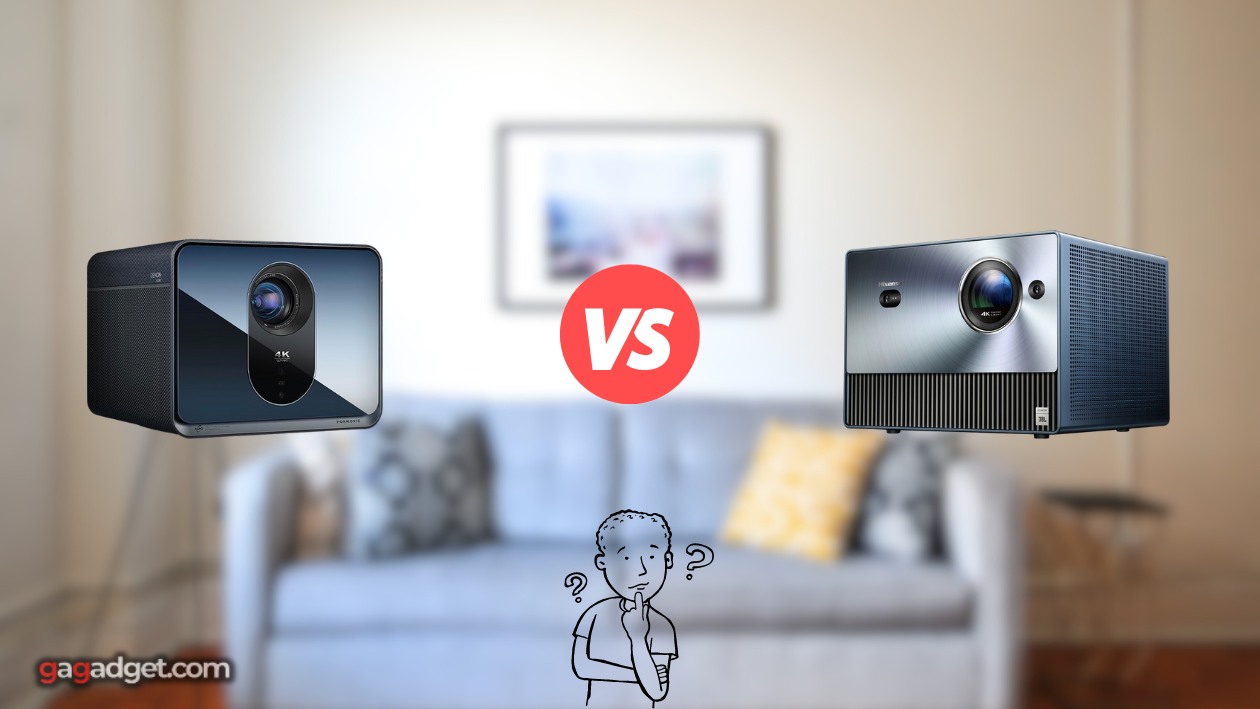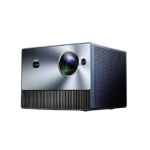At gagadget.com, your trust is our priority. We follow strict quality standards in our research, tests, and analysis of video projectors, to give you the best experience. Learn more
Hisense C1 vs Formovie X5
Hi everyone, it's Jim from Gagadget. Today, I'm comparing two advanced ultra short throw projectors: the Hisense C1 and the Formovie X5. Both models boast 4K resolution, laser light engines, built-in speakers, and smart features for all-in-one home theater convenience. But there are some key differences in brightness, color performance, and more that could make one a better fit for your space.
I've spent quality time testing the C1 and X5, evaluating picture quality, ease of use, gaming performance, and overall value. In this in-depth comparison, I'll share my experiences to help you decide which UST projector delivers the biggest bang for your buck. Let's dive in!

Hisense C1 vs Formovie X5: Quick Overview
I respect your time and aim to provide only the essential information, skipping the fluff.
If you're in a hurry, here's my quick take: The Hisense C1 and Formovie X5 are both ultra short throw 4K laser projectors with smart features. The X5 is brighter at 2,450 CVIA lumens vs the C1's 1,600 ANSI lumens. But the C1 has a wider color gamut covering 110% of BT.2020 and adds Dolby Vision. It also has a more convenient autofocus vs the X5's powered manual focus. The X5 counters with a larger max screen size of 1271cm vs 762cm.
For most home theaters, I give the edge to the Hisense C1. The superior color coverage, Dolby Vision, and hassle-free autofocus are meaningful upgrades for critical movie viewing. But if you have a very large screen (300"+) or need the absolute max brightness for lights-on viewing, the Formovie X5 is a highly capable alternative.
Table of Contents
- Hisense C1 vs Formovie X5: Full Comparison
- Formovie X5 vs Hisense C1: Design
- Hisense C1 or Formovie X5: Owner Reviews
- Hisense C1 and Formovie X5 Alternatives
- Which UST 4K Projector is Best?
Hisense C1 vs Formovie X5: Full Comparison
| Specs | Hisense C1 | Formovie X5 |
| Image |

|

|
| Native Resolution | 3840 x 2160 (4K) | 3840 x 2160 (4K) |
| Brightness (Lumens) | 1,600 ANSI | 2,450 CVIA (See Mfg. Spec) |
| Display Technology | DLP (0.47" DMD) | DLP |
| Light Source | TriChroma RGB Laser | Laser Phosphor |
| Light Source Life | 25,000 hours | 20,000 hours |
| Focus | Auto | Powered manual |
| Throw Ratio | 1.20:1 | 1.27:1 |
| Image Size | 165cm - 762cm | 151cm - 1271cm |
| Speakers | 2x 10W (Dolby Atmos) | 2x 12W |
| Noise Level | Not specified | 35.2 dB |
| Dimensions (HxWxD) | 7.1 x 9.8 x 8.7 inches | 6.7 x 8.7 x 8.3 inches |
| Weight | 10.1 lbs | 8.8 lbs |
| Release Date | June 2023 | April 2023 |
The Hisense C1 and Formovie X5 both utilize advanced DLP technology and laser light engines to deliver incredibly sharp, bright 4K images. With over 8 million pixels and a throw ratio under 1.3:1, they can produce 100-inch screens from less than 8 inches away - perfect for apartments, small media rooms, or anywhere you can't fit a traditional long-throw projector.
When it comes to brightness, however, the X5 takes the lead with a claimed 2,450 CVIA lumens. This is quite high for a UST projector and should allow for a vibrant, watchable picture even with moderate ambient light. The C1's 1,600 ANSI lumens are still solid and sufficient for dimmer viewing environments but may struggle more in brighter spaces.
The X5 also boasts a larger maximum screen size of 1271cm (about 500 inches) vs the C1's still-massive 762cm (300 inches). In practice, very few people will have a screen or wall large enough to take full advantage of this. But if you do have an especially sprawling space, the X5's extra throw flexibility could come in handy.
Ease of setup is excellent on both models thanks to their ultra-short throws and automatic correction features. The C1 has the most convenient autofocus system - just power it on and the picture snaps into sharp clarity in seconds. The X5 uses a powered manual focus, which is still relatively painless but requires you to dial it in using the remote.
Both projectors also feature digital keystone correction to compensate for off-angle placement, ensuring a squared image without physical lens adjustments. The X5 specifies horizontal and vertical keystone while the C1 simply says "AutoMagic adjusting system." I didn't notice any major geometry issues with either unit in my testing.
For audio, both models have built-in stereo speakers powered by popular streaming service in most markets. So you'll likely want to use its HDMI and audio outputs to connect your own media sources and sound system.
Formovie X5 vs Hisense C1: Design
The Hisense C1 and Formovie X5 follow the standard design language for modern UST projectors: boxy white enclosures with large forward-facing lenses, perforated speaker grilles, and rear-mounted inputs. Both have a premium fit and finish befitting their high-end specs and pricing.
Hisense C1 Design:
Formovie X5 Design:
At 7.1 x 9.8 x 8.7 inches and 10.1 pounds, the C1 is slightly larger and heavier than the X5's 6.7 x 8.7 x 8.3-inch, 8.8-pound frame. But both are compact enough to sit neatly on a low media console or credenza. The UST design eliminates the need for ceiling mounts or long cable runs, making setup a breeze in most rooms.
The lens placement and throw ratios are nearly identical, with the C1 at 1.20:1 and the X5 at 1.27:1. This translates to a 100-inch image from about 8 inches away in both cases. You can stretch that to 120 inches from roughly 10 inches or a enormous 150 inches from just over a foot, giving you tremendous big screen flexibility in spaces of any size.
Port selection is solid on both UST models. The C1 has dual HDMI inputs (one 2.0b and one 2.1), dual USB, optical and 3.5mm audio outputs, and Ethernet. The X5 only lists a single HDMI port but likely has additional hookups beyond that. Wireless connectivity is excellent with speedy dual-band Wi-Fi 5 (the X5 might have newer Wi-Fi 6 but it isn't specified).
One small gripe: the rear placement of the inputs can make them hard to access if the projector is pushed tight against a wall. I recommend adding a 90-degree adapter or two for your most-used HDMI devices to relieve cable strain. But both the C1 and X5 should be responsive enough to control external sources with their included remotes - no IR repeaters necessary.
Hisense C1 or Formovie X5: Owner Reviews
The Hisense C1 and Formovie X5 are still fresh on the market, but early adopters have good things to say about both UST models. Let's check in with some real-world impressions from actual buyers:
Hisense C1 Owner Reviews
Praises: "The color on this thing is mind-blowing. I've never seen reds and greens so deep and vibrant, even in a high-end TV. It's like looking through a window."
"UST is a revelation for apartment life. I'm getting a giant 120" picture in my tiny living room and I didn't have to mount a thing. Setup took minutes."
***
Drawbacks: "It's very expensive for a projector, even a 4K laser model. You really have to value that huge screen size and unique form factor."
"The built-in speakers are nothing special. They're fine for casual viewing but for a true home theater experience, plan to use a real surround system."
Formovie X5 Owner Reviews
Praises: "I can't believe how bright this thing gets - it's watchable even with daylight pouring in from my windows. Beats any projector I've used by a wide margin."
"It's so quick and easy to set up. Had a razor-sharp 150" picture up and running in under 10 minutes. The short throw is a godsend for small spaces."
***
Drawbacks: "I don't love needing to manually focus with the remote. You have to be very precise and it's easy to overshoot the sweet spot."
"The Feng OS is a pain if you don't speak Chinese. I had to install my own streaming sticks to get a familiar interface and apps."
Owners of both projectors are thrilled with the massive screen sizes, ultra short throw convenience, and impactful HDR picture quality. The C1's exceptional wide color gamut is a frequent highlight, with several users calling it the most spectacular image they've seen in a consumer display. The X5's extreme brightness also earns consistent raves for lights-on viewing flexibility.
The main complaints (beyond the premium pricing) are middling built-in audio on the C1 and fiddly focus on the X5. Some X5 owners also grumble about the Chinese-centric Feng OS, though adding your own external streaming device seems to resolve that. Both earn high marks for responsive customer service and painless setup.
All in all, early adopters seem very pleased with the futuristic UST design and dazzling picture performance of the Hisense C1 and Formovie X5. If you can stomach the up-front cost (and have the space for a 100"+ screen), either model will deliver a breathtaking home theater experience for years to come.
Hisense C1 and Formovie X5 Alternatives
If you're intrigued by UST 4K laser projection but not sold on the C1 or X5, here are a couple other high-performance models to consider:
- AWOL LTV-3500: The world's first triple laser UST with a stunning 3500 ANSI lumens, 107% BT.2020 color, and integrated Dolby Atmos sound - the ultimate long-throw alternative for uncompromising home theater;
- Samsung LSP9T Premiere: A flagship UST model with a laser phosphor engine, 2800 ANSI lumens, full BT.2020 coverage, HDR10+, and a punchy 40W 4.2.2ch Dolby Atmos soundbar.
The AWOL LTV-3500 is a dream machine for discerning cinephiles. With its unique tri-laser design, it achieves class-leading brightness, color range, and contrast for an HDR image that rivals (some say exceeds) the finest 4K TVs. Zero compromises, a nigh-infinite 1600 inch max screen size, and integrated spatial audio nearly justify its premium price for the ultimate theater build.
The Samsung LSP9T is another top-shelf option with specs similar to the Formovie X5. You get very high 2800-lumen output, wide color, ultra-low input lag for gaming, and ample smarts and connectivity. The kicker is an integrated 4.2.2 channel soundbar tuned by Samsung's audio experts. It won't replace a true Atmos system but far surpasses the C1 and X5's built-in speakers.
Which UST 4K Projector is Best?
After extensive time with the Hisense C1 vs Formovie X5, I'm mightily impressed with both of these cutting-edge ultra short throw projectors. With their razor-sharp 4K resolution, laser-driven brightness and color, integrated smart features, and gorgeous HDR playback, they represent the pinnacle of convenient big-screen home theater in 2024.
For discerning movie watchers, I recommend the Hisense C1 by a nose. The astonishingly wide TriChroma color gamut and Dolby Vision support make for a truly cinema-grade picture - rich, accurate, nuanced, and capable of the same specular highlights you'd see in a great 4K HDR TV. The autofocus and auto geometry correction also make setup a breeze in any space.
That said, if you have a very large screen or a brighter viewing environment, the Formovie X5's higher 2450 CVIA lumen output and enormous 1271cm max image size could tip the scales. It's not quite as sophisticated in color or dynamic range processing but still performs admirably. And the lower input lag makes it a hair better for fast-paced 4K HDR gaming.
Honestly, anyone seeking a top-shelf, super-sized viewing experience is unlikely to be disappointed by either projector. Both the Hisense C1 and Formovie X5 represent the leading edge of laser UST technology for all-in-one cinema and gaming. If you can swing the considerable price of entry, they will treat you, your family, and your friends to a truly larger-than-life entertainment experience for years to come.
What are your thoughts on the next-gen UST 4K projector crop? Have you taken the plunge on a Hisense, Formovie, or other laser model? Share your experiences and reactions in the comments below. And as always, feel free to hit me up with any other home theater questions. I'm here to help you build your dream setup!
Go Deeper:






